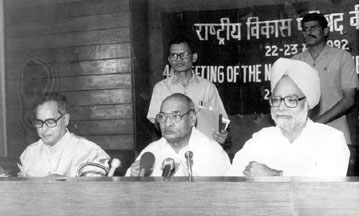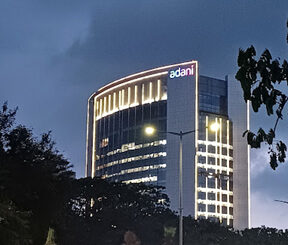
The average income of the middle class more than tripled in the 10 years that Manmohan Singh was PM. This was the golden period for the professional & managerial class in India.
“The Rao-Manmohan market reforms completely changed the ideological terrain. Now, the middle class became a facilitator of corporate profits. Its job was to maximize profits by increasing productivity in businesses. And, for that, it got a share of the returns to capital — much higher salaries than its previous ‘babu’ avatar could have got them. The post-liberalization middle class, therefore, imbibed the values of capitalism — pro-market and consumerist.”

Soon after Manmohan Singh became Finance Minister, the term multinational corporation, or MNC, entered our daily lexicon. I heard it first when a distant relative left a public sector job to join an MNC for a salary of Rs 30,000 per month. This was unheard of back then in middle-class families like ours.
But this was just the beginning. Soon, every young person around me was looking for a private sector job. MNCs had radically altered the white-collar job market by offering fabulous pay packages. Domestic companies had to follow suit. The middle class could now aspire to a lifestyle that it wouldn’t even have dared to dream of earlier.
Manmohan Singh, along with the then Prime Minster PV Narasimha Rao, made it possible. They unleashed policies that gave rise to a new affluent middle class.
First, let me explain what I mean by the term middle class. It is nowhere in the middle when it comes to India’s population. In fact, it sits right at the top — between the 96th and 99th percentile in terms of income. Its ‘middle-ness’ comes from where it stands in the economic system — as an intermediary between owners of capital and blue-collar workers.
Before liberalization gave the private sector control over the ‘commanding heights’ of the economy and set market forces to decide how resources would be allocated, it was largely controlled by the state and run by a bureaucratic-managerial-intellectual class. That was the old middle class, even smaller than it is now.
The old pre-liberalization middle class was ideologically oriented towards state intervention — what we have come to know as ‘Nehruvian socialism’. This was because its job was to implement policy decisions that were taken by the government and other arms of the state. Salaries were low, but jobs were secure. The middle class in its own self-image was constructed as a group of ‘nation builders’.
The Rao-Manmohan market reforms completely changed the ideological terrain. Now, the middle class became a facilitator of corporate profits. Its job was to maximize profits by increasing productivity in businesses. And, for that, it got a share of the returns to capital — much higher salaries than its previous ‘babu’ avatar could have got them. The post-liberalization middle class, therefore, imbibed the values of capitalism — pro-market and consumerist.
By the time Manmohan Singh’s first tryst with government ended in 1996, white-collar salaries in the private sector compared favorably with corporate jobs in the developed West, especially when purchasing power parity was taken into account. Sons and daughters of government servants began earning more in a month than their parents did in an entire year.
They bought cars, microwave ovens, washing machines and spring mattresses, retiled their bathrooms and took vacations to Phuket. They bought computers, invested in the stock markets and bought health insurance plans. Their kids now enrolled in schools with better infrastructure. When they fell sick, they went to new hospitals with private rooms that could put PSU-run hotels to shame.
And, the rise of the corporate executive in the 1990s and its changed spending habits had a multiplier effect on the entire middle class. Bankers, stock brokers, tax advisers, doctors, architects, interior decorators, chefs, fashion designers, all flourished in the new economic environment.
When Manmohan Singh became Prime Minister in 2004, the average income of those in the 96th-99th percentile had risen from roughly Rs 3,500 per month in 1991 to Rs Rs 16,000 per month.
Even in real, inflation-adjusted terms, it had nearly doubled in 13 years. To understand what that means, compare it to the 13 years before liberalization, when the average real incomes of the ‘middle class’ had increased by just 17 per cent.
This immense rise in middle class affluence was still nothing compared to what was to come in the UPA years. The average income of those in the 96th-to-99th percentile more than tripled in the 10 years that Manmohan Singh was PM. This was the golden period for
the professional-managerial class in India and its standard of living rose manifold. Middle-class families bought premium cars and flatscreen TV sets, ate at five-star hotels, holidayed in Europe and gated themselves into the toniest parts of India’s metros.
Manmohan Singh was only partly responsible for this. The first thrust of white-collar prosperity came from the credit-driven financial boom of the 2000s, which would ultimately end in the global financial crisis of 2008. Where the Manmohan-led UPA made a difference was in providing a massive fiscal stimulus to keep India out of a recession.
Much of it came in the form of the Sixth Pay Commission, which was implemented in August 2008, with retrospective effect from July 2006. Government servants got a lumpsum of arrears at one go, which they spent on buying cars, renovating their homes and sustaining the overall consumption in the economy when the corporate sector had taken a beating.
But corporate profits didn’t recover. The CMIE’s database shows that in the last five years of the Manmohan kaal, corporate earnings grew just six per cent annually, while inflation was 10 per cent. On the other hand, the corporate wage bill rose at 19 per cent per year.
The result was that from the second half of the 2010s, the corporate sector began cutting white-collar jobs and asking people to take pay cuts, to expand its profit margins. The net result is a rise in corporate profits, while ‘middle-class’ incomes have stagnated. Between 2018-19 and 2022-23, corporate profits increased at a real, inflation-adjusted rate of 53 per cent while the real income of the professional-managerial class has increased at just three per cent per year.
This is the inevitable result of the very market-friendly policies that created the affluent Indian middle class. It dramatically increased income and wealth inequality and, ultimately, created a shortage of demand for goods and services. That, in turn, caused corporate profits to fall, which made companies cut back on their wage bills, including what they paid their white-collar managerial staff. What would Dr Singh have done today to deal with the decimation of the middle class he helped create? We will no longer know.




Be the first to comment